194 cholesterol. Cholesterol Levels: Understanding the Healthy Ranges, Causes of High Cholesterol, and Effective Tips for Management
What are the healthy cholesterol levels for adults and children? What is considered high cholesterol and what factors can contribute to it? Get the answers and practical tips for maintaining optimal cholesterol levels.
Understanding Cholesterol Levels
Cholesterol is a waxy, fat-like substance found in the blood, and it plays a crucial role in various bodily functions. There are two main types of cholesterol: low-density lipoprotein (LDL), often referred to as “bad” cholesterol, and high-density lipoprotein (HDL), known as “good” cholesterol.
Maintaining a healthy balance of these cholesterol types is essential for overall cardiovascular health. When there is too much LDL cholesterol in the bloodstream, it can build up in the blood vessels, forming fatty deposits called plaques. This can lead to the narrowing and hardening of the arteries, a condition known as atherosclerosis, which increases the risk of heart attacks and strokes.

Cholesterol Levels by Age and Gender
Cholesterol levels tend to increase with age, and they can also vary by gender. According to the National Institutes of Health (NIH), the healthy cholesterol levels for different age groups and genders are as follows:
- Anyone 19 or younger:
- Total cholesterol: less than 170 mg/dl
- Non-HDL: less than 120 mg/dl
- LDL: less than 100 mg/dl
- HDL: more than 45 mg/dl
- Men aged 20 or over:
- Total cholesterol: 125-200 mg/dl
- Non-HDL: less than 130 mg/dl
- LDL: less than 100 mg/dl
- HDL: 40 mg/dl or higher
- Women aged 20 or over:
- Total cholesterol: 125-200 mg/dl
- Non-HDL: less than 130 mg/dl
- LDL: less than 100 mg/dl
- HDL: 50 mg/dl or higher
It’s important to note that these are general guidelines, and individual factors such as overall health, family history, and lifestyle choices can influence a person’s optimal cholesterol levels.
What is Considered High Cholesterol?
According to the Centers for Disease Control and Prevention (CDC), a total cholesterol level of 200 mg/dl or higher is considered high for adults. The specific ranges for high cholesterol are as follows:
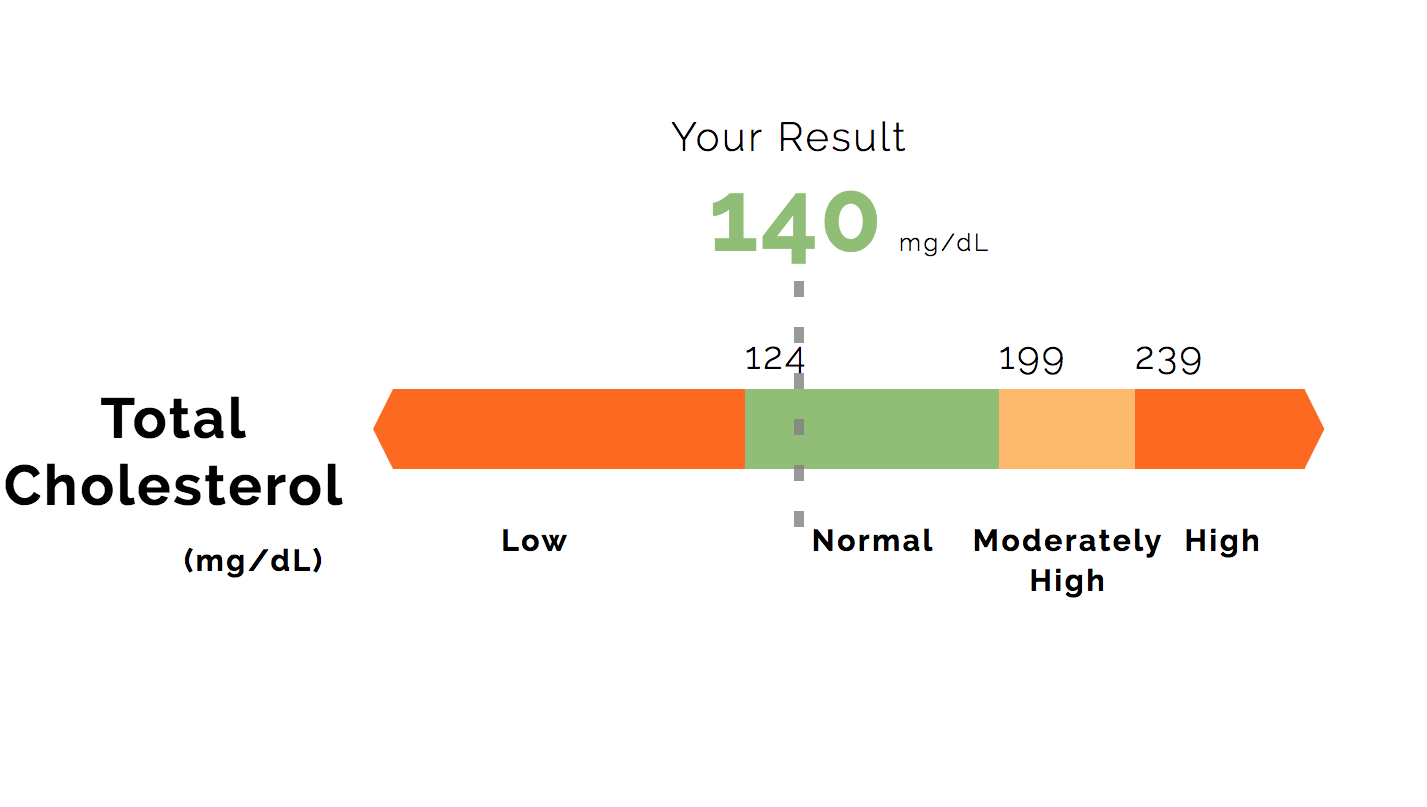
- Total cholesterol:
- Healthy: less than 200 mg/dl
- Borderline high: 200-239 mg/dl
- High: 240 mg/dl or higher
- LDL cholesterol:
- Optimal: less than 100 mg/dl
- Near optimal/above optimal: 100-129 mg/dl
- Borderline high: 130-159 mg/dl
- High: 160-189 mg/dl
- Very high: 190 mg/dl or higher
- HDL cholesterol:
- Optimal: 60 mg/dl or higher
- Borderline low: 41-59 mg/dl
- Low: less than 40 mg/dl
For children, the American Academy of Pediatrics considers total cholesterol levels of 200 mg/dl or higher to be high, with a borderline high range of 170-199 mg/dl.
Factors that Contribute to High Cholesterol
According to the CDC, several health conditions and lifestyle factors can contribute to high cholesterol levels, including:
- Type 2 diabetes
- Familial hypercholesterolemia (a genetic condition that causes high cholesterol)
- A diet high in saturated fats
- Lack of physical activity
- Smoking
- Obesity
- Genetics and family history of high cholesterol
Tips for Maintaining Healthy Cholesterol Levels
The National Institutes of Health (NIH) recommends the following strategies for lowering and maintaining healthy cholesterol levels:
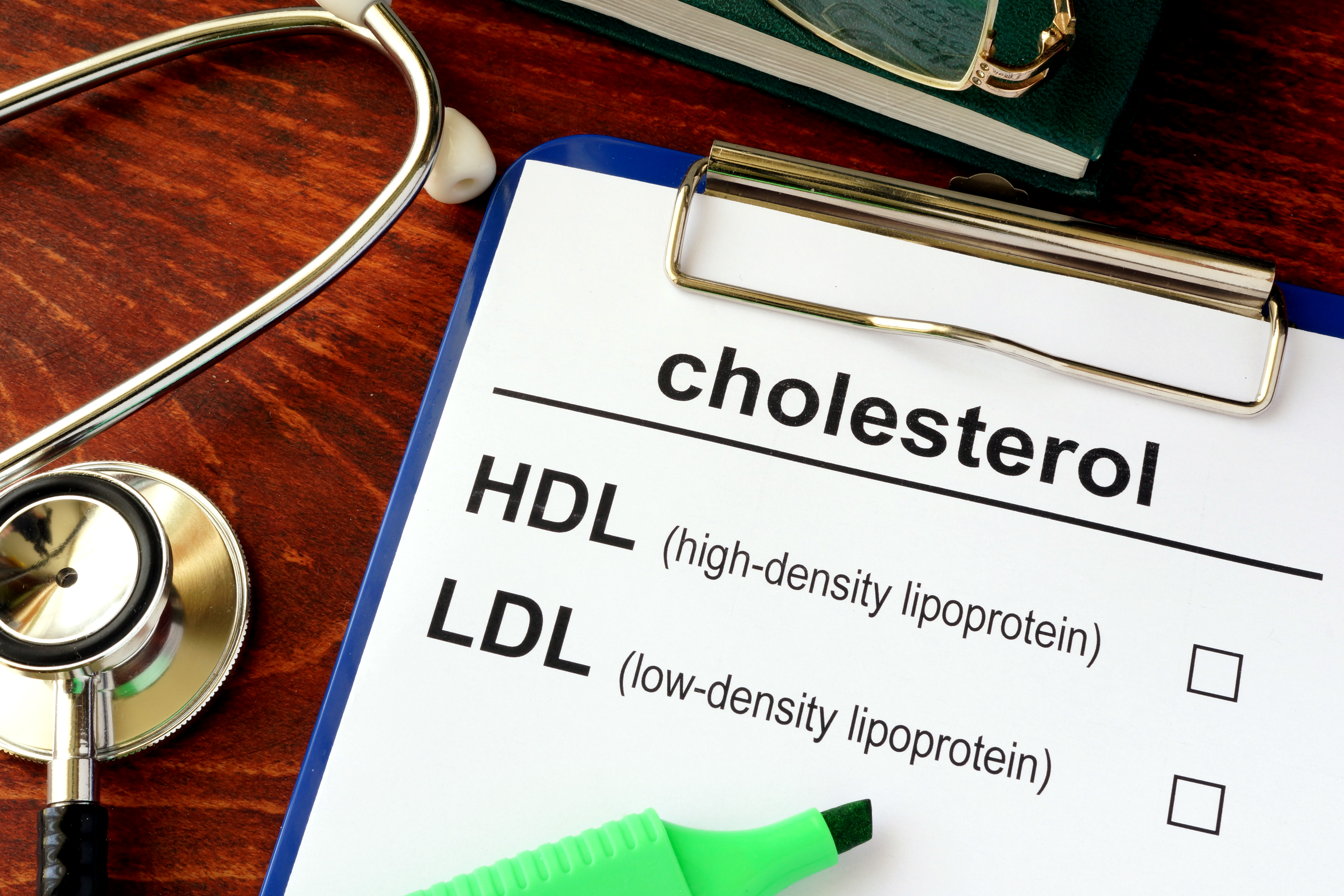
- Adopt a heart-healthy diet rich in fruits, vegetables, lean proteins, and whole grains.
- Engage in regular physical activity, such as at least 30 minutes of moderate exercise most days of the week.
- Quit smoking, if applicable.
- Achieve and maintain a healthy weight.
- Manage stress effectively.
In addition to these lifestyle changes, some individuals may also require medication, such as statins, to help lower their cholesterol levels. It’s important to work closely with a healthcare provider to determine the best course of action for maintaining optimal cholesterol levels and reducing the risk of heart disease.
Monitoring Cholesterol Levels
The CDC recommends that adults aged 20 and over have their cholesterol levels checked every 5 years, or more frequently if they have other risk factors for cardiovascular disease. Children may only need to have their cholesterol levels checked twice before they turn 18, unless they have risk factors that warrant more frequent monitoring.

Regular cholesterol screening and proactive management of any high or concerning levels can help individuals maintain optimal heart health and reduce their risk of serious cardiovascular events, such as heart attacks and strokes.
Health ranges, what is high, and tips
Cholesterol levels vary by age, weight, and sex. These levels typically increase with age, and people over 20 should check their cholesterol levels every 5 years.
The Centers for Disease Control and Prevention (CDC) estimate that nearly 94 million adults in the United States have high cholesterol. This increases a person’s risk of heart disease and stroke.
In this article, we explain how doctors measure cholesterol, and we describe the healthy levels at different stages of life. We also look at ways of lowering cholesterol and maintaining healthy levels.
Cholesterol is a waxy, fat-like substance, and there are two types: low-density lipoprotein (LDL) and high-density lipoprotein (HDL).
If there is too much LDL, or “bad,” cholesterol in the bloodstream, it can build up in blood vessels, forming fatty deposits called plaques.These plaques can lead to other problems, including heart attacks and strokes.
Total and LDL cholesterol levels should be low. But having more HDL, or “good,” cholesterol in the blood may reduce the risk of a heart attack or stroke.
But having more HDL, or “good,” cholesterol in the blood may reduce the risk of a heart attack or stroke.
Doctors can measure HDL, LDL, and total cholesterol levels. The results may also show levels of all non-HDL fats that can raise the risk of heart disease.
Cholesterol levels tend to increase with age. Taking steps to reach or maintain healthy levels earlier in life may prevent them from becoming dangerously high over time. Years of unmanaged cholesterol levels can be challenging to treat.
The CDC recommends that people aged 20 or over check their cholesterol levels every 5 years, or more frequently if they have other cardiovascular disease risk factors.
Children are less likely to have high cholesterol, and doctors may only need to check their levels twice before they turn 18 years old.
However, kids with risk factors for high cholesterol should have their levels checked more frequently.
Typically, males tend to have higher levels throughout their lives than females. A male’s cholesterol levels increase with age, and a female’s cholesterol levels rise after menopause.
A male’s cholesterol levels increase with age, and a female’s cholesterol levels rise after menopause.
The table below shows healthy levels of cholesterol by age, according to the National Institutes of Health (NIH). Doctors measure cholesterol in milligrams per deciliter (mg/dl).
| Type of cholesterol | Anyone 19 or younger | Men aged 20 or over | Women aged 20 or over |
| total cholesterol | less than 170 mg/dl | 125–200 mg/dl | 125–200 mg/dl |
| non-HDL | less than 120 mg/dl | less than 130 mg/dl | less than 130 mg/dl |
| LDL | less than 100 mg/dl | less than 100 mg/dl | less than 100 mg/dl |
| HDL | more than 45 mg/dl | 40 mg/dl or higher | 50 mg/dl or higher |
Aging aside, any changes in cholesterol levels usually stem from health conditions and lifestyle factors.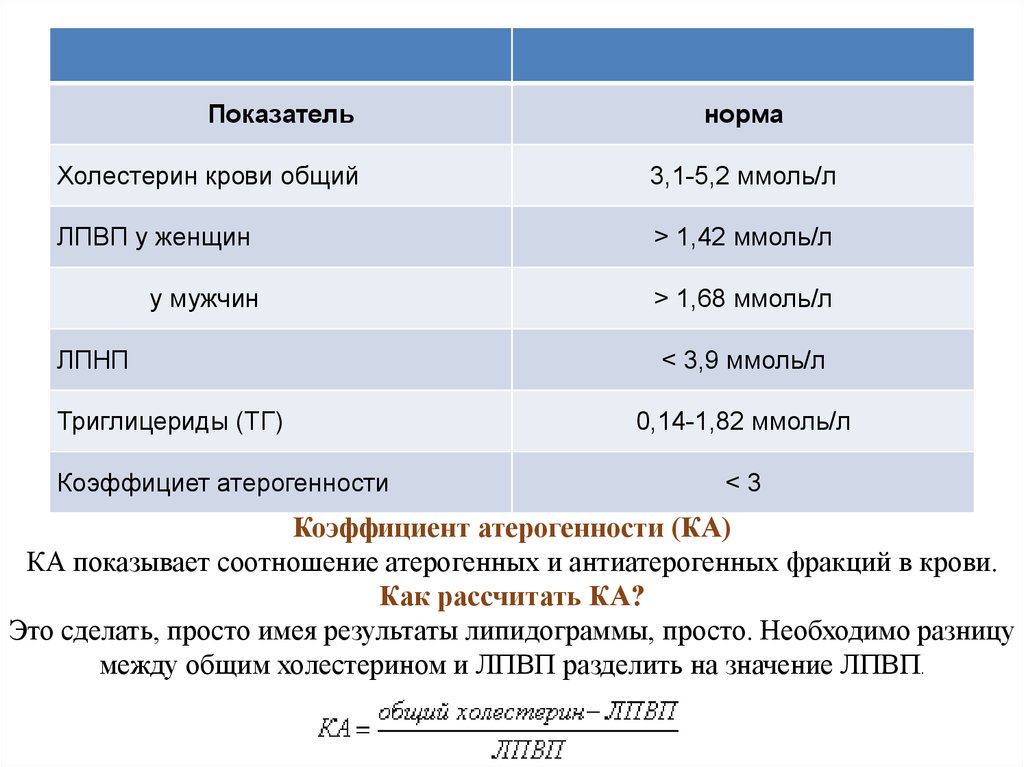
Below, we describe healthy and unhealthy ranges in more detail.
Cholesterol levels for adults
A doctor may classify a person’s levels as high or low, borderline, or healthy.
Total cholesterol
Total cholesterol levels under 200 mg/dl are healthy for adults.
Doctors treat readings of 200–239 mg/dl as borderline high, and readings of at least 240 mg/dl as high.
LDL cholesterol
Ideally, LDL cholesterol levels should be less than 100 mg/dl. Doctors may not express concern about levels of 100–129 mg/dl for people with no health issues, but they may suggest treatment at this stage for people with heart disease or its risk factors.
If a person’s reading is 130–159 mg/dl, it is borderline high, while readings of 160–189 mg/dl are high. A reading of at least 190 mg/dl is very high.
HDL cholesterol
Doctors recommend keeping HDL levels higher. People with a reading of less than 40 mg/dl may have a risk of heart disease.
If a person’s reading is 41–59 mg/dl, doctors consider this borderline low. Optimal HDL levels are 60 mg/dl or higher.
Cholesterol levels for children
According to the American Academy of Pediatrics, children should have total cholesterol readings of under 170 mg/dl.
The borderline high range is 170–199 mg/dl, and a reading of 200 mg/dl or over is high.
LDL cholesterol levels should be under 110 mg/dl. The borderline high range is 110–129 mg/dl, and any reading over 130 mg/dl is high.
Other factors that affect blood cholesterol
The CDC point outs that some health conditions and lifestyle factors can raise cholesterol levels. It says that type 2 diabetes, for example, raises LDL cholesterol levels, as does familial hypercholesterolemia.
The CDC also states that having a diet high in saturated fats and getting low levels of exercise may contribute to high cholesterol levels.
In addition, it acknowledges that having family members with high cholesterol increases a person’s risk.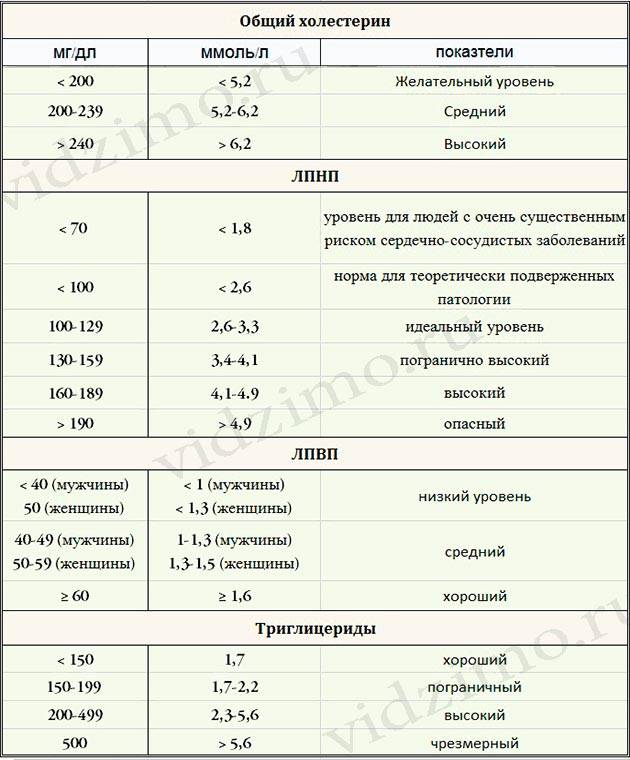
The NIH recommends these strategies for lowering cholesterol levels:
- having a diet rich in heart-healthy foods, including plenty of fruits and vegetables, lean proteins, and whole grains
- becoming more physically active
- quitting smoking, if this applies
- having a moderate weight
- managing stress
The NIH recommends consulting a healthcare professional before starting a new exercise plan, but overall, it advises a person to get at least 30 minutes of exercise a day.
Having a healthy diet and getting plenty of exercise can also bring down high cholesterol levels in children.
Generally, the earlier a person starts making these changes, the better for their cholesterol levels, as cholesterol builds up over time.
High cholesterol at any age increases the risk of heart disease, heart attack, and stroke. These risks only increase over time.
Drug therapies to treat high cholesterol
When lifestyle changes alone cannot bring down high cholesterol, doctors may recommend medications. The CDC reports that the following drugs and supplements can help:
The CDC reports that the following drugs and supplements can help:
- Statins: These drugs keep the liver from producing cholesterol.
- Bile acid sequestrants: These drugs reduce the amount of fat that the body absorbs from food.
- Cholesterol absorption inhibitors: These drugs lower levels of fats called triglycerides in the blood and reduce the amount of cholesterol absorbed from food.
- Some vitamins and supplements: These, such as niacin, stop the liver from removing HDL and lower levels of triglycerides.
- Omega-3 fatty acids: These raise HDL levels and lower triglyceride levels.
Before the age of 18, a doctor should check a child’s cholesterol levels at least twice. If the child’s family has a history of heart disease, overweight, or certain other health conditions, doctors may recommend checking levels more often.
A healthcare professional should check cholesterol levels in adults aged 20 or older every 4–6 years.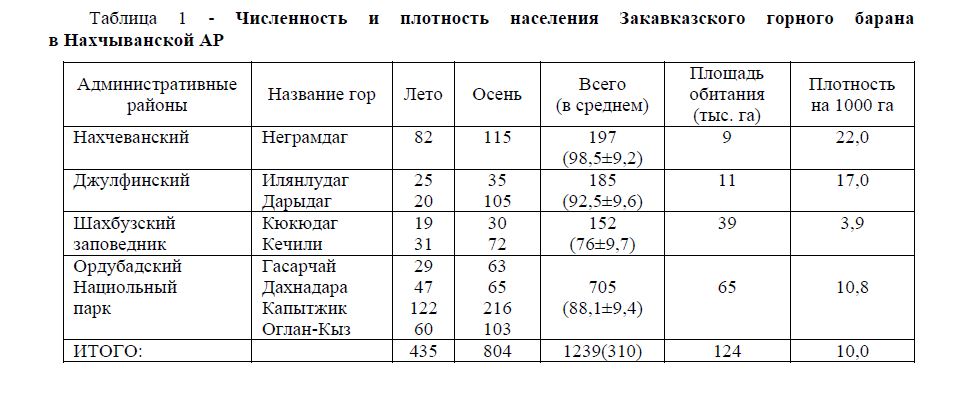
The doctor may recommend treatment if:
- The results show high or borderline high levels of total and LDL cholesterol.
- The person is overweight.
- The person has a family history of heart disease.
Cholesterol levels increase with age, and having high cholesterol at any age increases the risk of heart attacks and strokes.
Reaching or maintaining healthy levels may involve lifestyle changes, and if these are not enough, prescription medication.
A doctor should check cholesterol levels in adults, starting at the age of 20, every 4–6 years.
Health ranges, what is high, and tips
Cholesterol levels vary by age, weight, and sex. These levels typically increase with age, and people over 20 should check their cholesterol levels every 5 years.
The Centers for Disease Control and Prevention (CDC) estimate that nearly 94 million adults in the United States have high cholesterol. This increases a person’s risk of heart disease and stroke.
In this article, we explain how doctors measure cholesterol, and we describe the healthy levels at different stages of life. We also look at ways of lowering cholesterol and maintaining healthy levels.
Cholesterol is a waxy, fat-like substance, and there are two types: low-density lipoprotein (LDL) and high-density lipoprotein (HDL).
If there is too much LDL, or “bad,” cholesterol in the bloodstream, it can build up in blood vessels, forming fatty deposits called plaques.These plaques can lead to other problems, including heart attacks and strokes.
Total and LDL cholesterol levels should be low. But having more HDL, or “good,” cholesterol in the blood may reduce the risk of a heart attack or stroke.
Doctors can measure HDL, LDL, and total cholesterol levels. The results may also show levels of all non-HDL fats that can raise the risk of heart disease.
Cholesterol levels tend to increase with age. Taking steps to reach or maintain healthy levels earlier in life may prevent them from becoming dangerously high over time. Years of unmanaged cholesterol levels can be challenging to treat.
Years of unmanaged cholesterol levels can be challenging to treat.
The CDC recommends that people aged 20 or over check their cholesterol levels every 5 years, or more frequently if they have other cardiovascular disease risk factors.
Children are less likely to have high cholesterol, and doctors may only need to check their levels twice before they turn 18 years old.
However, kids with risk factors for high cholesterol should have their levels checked more frequently.
Typically, males tend to have higher levels throughout their lives than females. A male’s cholesterol levels increase with age, and a female’s cholesterol levels rise after menopause.
The table below shows healthy levels of cholesterol by age, according to the National Institutes of Health (NIH). Doctors measure cholesterol in milligrams per deciliter (mg/dl).
| Type of cholesterol | Anyone 19 or younger | Men aged 20 or over | Women aged 20 or over |
| total cholesterol | less than 170 mg/dl | 125–200 mg/dl | 125–200 mg/dl |
| non-HDL | less than 120 mg/dl | less than 130 mg/dl | less than 130 mg/dl |
| LDL | less than 100 mg/dl | less than 100 mg/dl | less than 100 mg/dl |
| HDL | more than 45 mg/dl | 40 mg/dl or higher | 50 mg/dl or higher |
Aging aside, any changes in cholesterol levels usually stem from health conditions and lifestyle factors.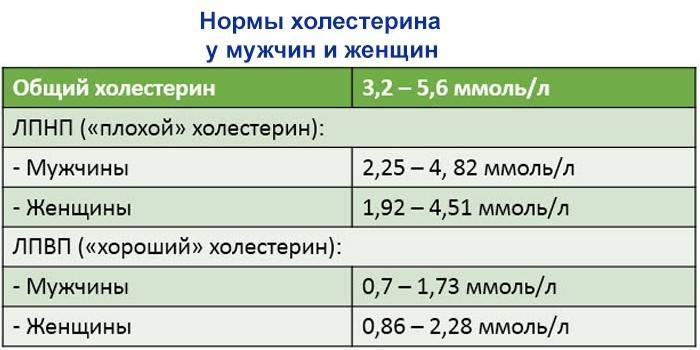
Below, we describe healthy and unhealthy ranges in more detail.
Cholesterol levels for adults
A doctor may classify a person’s levels as high or low, borderline, or healthy.
Total cholesterol
Total cholesterol levels under 200 mg/dl are healthy for adults.
Doctors treat readings of 200–239 mg/dl as borderline high, and readings of at least 240 mg/dl as high.
LDL cholesterol
Ideally, LDL cholesterol levels should be less than 100 mg/dl. Doctors may not express concern about levels of 100–129 mg/dl for people with no health issues, but they may suggest treatment at this stage for people with heart disease or its risk factors.
If a person’s reading is 130–159 mg/dl, it is borderline high, while readings of 160–189 mg/dl are high. A reading of at least 190 mg/dl is very high.
HDL cholesterol
Doctors recommend keeping HDL levels higher. People with a reading of less than 40 mg/dl may have a risk of heart disease.
If a person’s reading is 41–59 mg/dl, doctors consider this borderline low. Optimal HDL levels are 60 mg/dl or higher.
Cholesterol levels for children
According to the American Academy of Pediatrics, children should have total cholesterol readings of under 170 mg/dl.
The borderline high range is 170–199 mg/dl, and a reading of 200 mg/dl or over is high.
LDL cholesterol levels should be under 110 mg/dl. The borderline high range is 110–129 mg/dl, and any reading over 130 mg/dl is high.
Other factors that affect blood cholesterol
The CDC point outs that some health conditions and lifestyle factors can raise cholesterol levels. It says that type 2 diabetes, for example, raises LDL cholesterol levels, as does familial hypercholesterolemia.
The CDC also states that having a diet high in saturated fats and getting low levels of exercise may contribute to high cholesterol levels.
In addition, it acknowledges that having family members with high cholesterol increases a person’s risk.
The NIH recommends these strategies for lowering cholesterol levels:
- having a diet rich in heart-healthy foods, including plenty of fruits and vegetables, lean proteins, and whole grains
- becoming more physically active
- quitting smoking, if this applies
- having a moderate weight
- managing stress
The NIH recommends consulting a healthcare professional before starting a new exercise plan, but overall, it advises a person to get at least 30 minutes of exercise a day.
Having a healthy diet and getting plenty of exercise can also bring down high cholesterol levels in children.
Generally, the earlier a person starts making these changes, the better for their cholesterol levels, as cholesterol builds up over time.
High cholesterol at any age increases the risk of heart disease, heart attack, and stroke. These risks only increase over time.
Drug therapies to treat high cholesterol
When lifestyle changes alone cannot bring down high cholesterol, doctors may recommend medications. The CDC reports that the following drugs and supplements can help:
The CDC reports that the following drugs and supplements can help:
- Statins: These drugs keep the liver from producing cholesterol.
- Bile acid sequestrants: These drugs reduce the amount of fat that the body absorbs from food.
- Cholesterol absorption inhibitors: These drugs lower levels of fats called triglycerides in the blood and reduce the amount of cholesterol absorbed from food.
- Some vitamins and supplements: These, such as niacin, stop the liver from removing HDL and lower levels of triglycerides.
- Omega-3 fatty acids: These raise HDL levels and lower triglyceride levels.
Before the age of 18, a doctor should check a child’s cholesterol levels at least twice. If the child’s family has a history of heart disease, overweight, or certain other health conditions, doctors may recommend checking levels more often.
A healthcare professional should check cholesterol levels in adults aged 20 or older every 4–6 years.
The doctor may recommend treatment if:
- The results show high or borderline high levels of total and LDL cholesterol.
- The person is overweight.
- The person has a family history of heart disease.
Cholesterol levels increase with age, and having high cholesterol at any age increases the risk of heart attacks and strokes.
Reaching or maintaining healthy levels may involve lifestyle changes, and if these are not enough, prescription medication.
A doctor should check cholesterol levels in adults, starting at the age of 20, every 4–6 years.
Annual preventive examination after 40 years for women
Your online assistant
We will help you choose tests, calculate the cost, make an appointment.
Write to chat…
Total cost
1,600 rubles
The field is not filled in the place of analysis
Back to the list
Composition of a comprehensive study
GGTP
No. L04.02.005
1 day 25
No.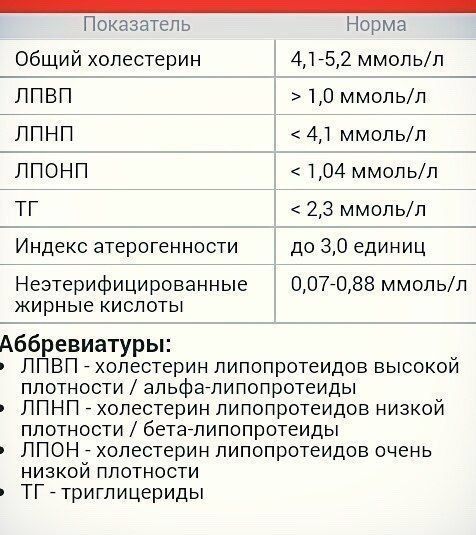 L08.00.005
L08.00.005
1 day
T4 free
No. L06.01.002
1 day
ALT
No. L04.02.001
1 day
Total bilirubin
No. L04.01.001
1 day
Clinical blood test with leukocyte formula (5DIFF )
No. L01.00.003
1 day
ESR
No. L01.00.001
1 day
Urinalysis
No. L 21.01.001
1 day
Urea
No. L04.03.005
1 day
Homocysteine
№ L04.06.009
1 day
1 275 ₽
Creatinine
№ L0 4.03.004
1 day
Glucose
No. L04.05.001
1 day
AST
No. L04.02.002
1 day
Direct bilirubin
No. L04.01.002
1 day
Total protein
No. L04.03.002
1 day
HDL cholesterol
No. L04.06.003
1 day
Total cholesterol
Ref. 04 1 day
Alkaline phosphatase
No. L04.02.003
1 day
SA 15-3
No. L08.00.008
L08.00.008
1 day
Triglycerides
No. L04.06.001
1 day
TSH
900 04 No. L06.01.001
1 day
Popular comprehensive analyzes
Biochemical blood test, basic
article
№ L50.00.004
term
1 day
price
1 720 ₽
- Alkaline phosphatase
- Total cholesterol
- Total protein
- AST
- Glucose
- C-reactive protein
- Creatinine
- Iron
- Total bilirubin
- ALT
Lipid profile, extended
Allows to identify the risk of developing atherosclerosis and cardiovascular diseases
article
No. L50.00.008
term
3 days
price
2 636 ₽
901 66
Diagnostics of sexually transmitted infections (serum markers)
article
№ L50. 00.032
00.032
term
6 days
price
4 314 ₽
- , total
- Antibodies to herpes simplex virus 1, 2 types , IgG
- Antibodies to hepatitis C virus, total
- Treponema pallidum antibodies, total
- Hepatitis B surface antigen
- HIV (antibodies and antigens)
Hormonal profile for women, screening
article
No. L50.00.024
term
1 day
price
1 440 ₽
901 66
Annual preventive examination after 40 years for men
article
№ L50.05.003
term
1 day
price
4 082 ₽
90 166
Diagnosis of parasitic diseases (serum markers)
article
No. L50.00.033
L50.00.033
term
3 days
90 004 price
3 400 ₽
- Ascaris antibodies, IgG
- Antibodies to echinococcus, IgG
- Immunoglobulin E (IgE)
- Clinical blood test with leukocyte formula (5DIFF)
- Antibodies to trichinella, IgG
- Antibodies to Helicobacter, IgG
Choose your city
Unfortunately, there are no clinics in your city.
You can choose the nearest city from the list:
- Astrakhan
- Achkhoi-Martan
- Baksan
- Grozny
- Gudermes
- Moscow
- Nalchik
- Tver
- Uchkeken
- Khasavyurt
- Elista
901 67 Prokhladny
Get test results
To view results analyzes fill in the fields.
Contract number
Where the number is indicated
contracts?
Password
Where indicated
password?
Custom
agreements
Federal network of medical centers
Clinics of the Capital
Clinics of the Capital specializes in high-quality laboratory
diagnostics and medical services.
A new standard of trust.
200+
highly qualified specialists
16
cities
in Russia
1 500
types
studies
Specify the details of the patient for whom the service is needed 004 Surname
First name
Middle name
Phone
Enter the details of the patient for whom you need service
Surname
First name
Middle name
Phone
Enter the details of the patient for whom the service is needed
Last name and first name
Phone to confirm the appointment
Enter your details and we will call you back
Last name
First name
Phone
Login to your personal account
900 04 View visit history, all test results
Phone or email. e-mail
Password
Retrieve password
Login to your personal account
View visit history, all test results
Phone or email.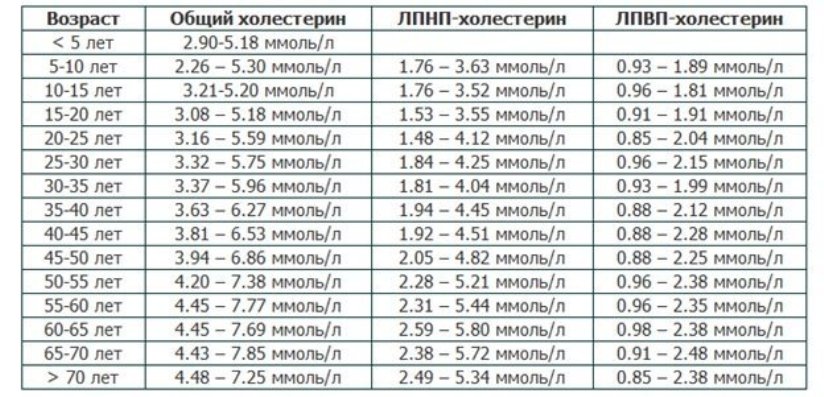 mail
mail
Password
Retrieve password
Retrieve password
Enter phone number
I found the password
Login to your personal account
View the history of visits, all test results
Phone or email Email
Password
Reset password
Your data has been sent. Our administrator will call you back as soon as possible.
We will call you back as soon as possible.
Orenburg Regional Clinical Hospital
We are glad to welcome you on the official website of our hospital!
The State Autonomous Institution of Healthcare “Orenburg Regional Clinical Hospital named after V.I. Voinov” (GAUZ “OOKB IM.V.I. Voynov”) has been a leader in the health care of the region for over 150 years. Thanks to the activities of the staff of our institution and careful attitude to the traditions laid down by our predecessors, we continue to improve the quality and efficiency of medical care. A powerful material and technical base, high human resources, the use of effective diagnostic and treatment methods make it possible to provide specialized, including high-tech, medical care to the population of the Orenburg region and other regions.
The capacity of the hospital is 933 beds. Since 2007, the GAUZ “OOKB named after V.I. Voynov” has been included in the list of institutions providing high-tech medical care under federal quotas. Since January 10, 2013, a regional vascular center with 120 beds has been operating in our hospital, and on January 1, 2014, a regional nephrology center began to work on the basis of the nephrology department.
The capacity of the consultative polyclinic is 600 visits per shift, admission is carried out in 28 specialties.
Over 24,000 patients are treated annually in the inpatient departments of the hospital.
In addition, on a daily basis, specialists from the emergency medical advisory department provide emergency assistance in case of complicated diseases, injuries, and, if necessary, surgical interventions are performed by road and air ambulance transport.
Of the 404 doctors working in the hospital, 4 have the degree of doctor of medical sciences, 33 are candidates of medical sciences, 159 doctors have the highest qualification category.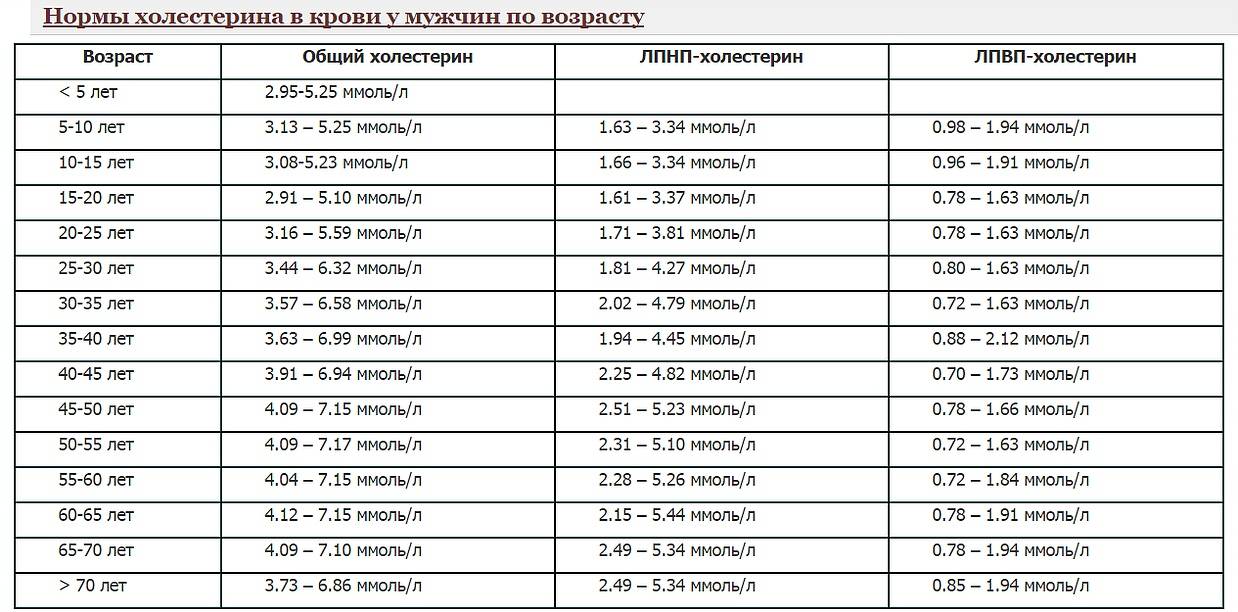 Out of 719 paramedical workers, 249the highest qualification category, 26 nurses have higher nursing education. 7 doctors of our hospital have the honorary title “Honored Doctor of the Russian Federation”, 6 – the honorary title “Honored Health Worker of the Russian Federation”. 31 doctors and 6 paramedical workers were awarded with the badge “Excellent Health Worker”. The diploma of the Ministry of Health of the Russian Federation has 32, the diploma of the Ministry of Health of the Orenburg region – 94 hospital workers.
Out of 719 paramedical workers, 249the highest qualification category, 26 nurses have higher nursing education. 7 doctors of our hospital have the honorary title “Honored Doctor of the Russian Federation”, 6 – the honorary title “Honored Health Worker of the Russian Federation”. 31 doctors and 6 paramedical workers were awarded with the badge “Excellent Health Worker”. The diploma of the Ministry of Health of the Russian Federation has 32, the diploma of the Ministry of Health of the Orenburg region – 94 hospital workers.
The joint work of the regional clinical hospital and the Orenburg State Medical University (institute, academy) on the training of medical personnel of the highest level has more than 70 years of history. Currently, five departments of SBEE HPE “Orenburg State Medical University” work at our base.
For the training of mid-level personnel on the basis of the institution, there are an evening department and a department for postgraduate training of specialists with secondary medical and pharmaceutical education of the regional medical college.
